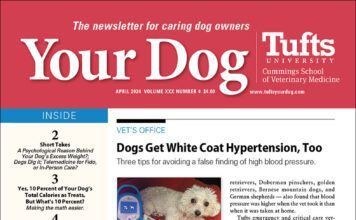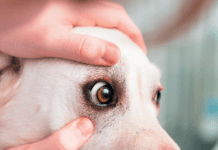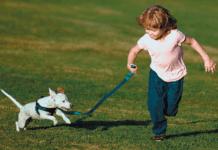Even When Nothing Seems Wrong, Your Dog’s Eyes Need Checking
Of course, if one or both of your dog’s eyes have turned red or cloudy, or there is discharge, you should bring him to the doctor to see what’s going on. Ditto if your dog’s eyes appear to be causing him discomfort. You might notice a fair amount of squinting, rubbing at his eyes with his paws, or moving away when you go to touch his head. But eye exams should also be included in his regular check-ups even when nothing seems wrong. Just as with people, something may be going on that isn’t apparent. A basic ocular exam consists of three things:
What You Need to Know Before Your Dog Undergoes Anesthesia
In 2008, the risk of death for a healthy dog undergoing anesthesia was deemed to be one in 2,000, according to a study that appeared in the journal Veterinary Anaesthesia and Analgesia. That risk is probably even lower now. Monitoring techniques and anesthetic drugs themselves keep improving. But just as for people, the risk is not zero. Indeed, when researchers included dogs with health problems along with healthy dogs in their 2008 assessment, the risk of death with anesthesia was considered to be as high as one in 600.
Should Your Dog Be Screened for Cancer Younger?
We know that the incidence of breast cancer in women goes up dramatically starting at around age 55, so screening with mammograms is recommended when the disease might have developed but before there are any outward signs — starting no later than age 50 and perhaps even as young as 40. It’s the same when it comes to screening men for prostate cancer. The average age of diagnosis is 66, and screening with a PSA test is recommended starting no later than age 55. Screening for other cancers, such as colon cancer, is also recommended before someone is likely to start feeling different or showing signs of the disease. Could such an approach be used for dogs so that canine cancer is caught as early as possible, with the best chance for treatment that could save an animal’s life?
Short Takes July 2023
Veterinarians Can Now Become Board-Certified in Shelter Medicine
Snack Bag Suffocation: It’s a Thing
Videos of dogs with bags around their heads are popular on social media — a shame because a dog with his head stuck in a bag is scared. Worse, he’s in grave danger. A pet can suffocate in less than 5 minutes when his head becomes lodged in a bag. Figures for how often that happens are lacking, but the Food and Drug Administration says that “although this may seem like an odd scenario, it plays out more commonly than you realize.”
Download The Full July 2023 Issue PDF
- Snack Bag Suffocation: It’s a Thing
- Short Takes
- Should Your Dog Be Screened for Cancer Younger?
- What You Need to Know Before Your Dog Undergoes Anesthesia
- Even When Nothing Seems Wrong, Your Dog’s Eyes Need Checking
- A Proper Diet For Your Dog Contains Less Meat Than You May Think
- When Choosing Health Insurance For Your Dog, Consider Dental Care
- Dear Doctor
Download The Full June 2023 Issue PDF
- Making It Illegal for Your Dog to Stick His Head Out the Car Window
- Short Takes
- But What’s With Their Tails?
- Are Black Dogs Less Likely to Be Adopted?
- Labrador Retrievers Ousted From Number 1 Spot as Most Popular Breed
- Recognizing “Swimmer’s Ear” and Other Dog-Eared Problems
- When Your Rescue Dog Turns Aggressive On You
- If Your Dog Won’t Take the Medicine, Can It Be Compounded?
- Dear Doctor
Making It Illegal for Your Dog to Stick His Head Out the Car Window
Few sights are as endearing to a dog lover as seeing a canine exuberantly sticking his head out the car window and feeling the breeze on his face. And many dog lovers like to extend that pleasure to their own pets. But it is dangerous. A dog can get hurt by flying pebbles thrown up by other cars. Dust can get into his eyes. And the flapping of soft ears in the wind can irritate them, make them swell, and cause damage. Dogs have fallen out of car windows, too. All it takes is one too-fast turn around a bend for a dog to lose his footing.
Marijuana Toxicity in Dogs on the Rise
As the legalization of marijuana expands, veterinary emergency rooms are seeing an increase in canine cases of marijuana toxicity, according to research published in the Journal of Veterinary Emergency and Critical Care. The problem most commonly occurs via ingestion, although inhalation can also cause problems. Common clinical signs of marijuana poisoning include urinary incontinence, disorientation, drunken gait, lethargy, hyperesthesia (increased reactivity), and low heart rate.
You Cannot Diagnose Mouth Pain By How Much Your Dog Eats
People often assume that if their dog had mouth pain, he would stop eating. Not true, say Tufts health professionals Yuki Nakayama, DVM, and certified veterinary technician Kate Zukowski. They report that dogs rarely stop eating due to oral pain, getting around it by chewing on the other side, swallowing their food whole, or perhaps showing a preference for softer foods.
Over-the-Counter Antimicrobials Now Available By Prescription Only
Until now, certain antimicrobial medicines used in dogs and other animals have been available over the counter. That ends this month. As of June 11th, all antimicrobial medicines for animals that are also important in human medicine must be prescribed by a veterinarian, says the Food and Drug Administration. The move is aimed to ensure judicious use of these drugs and retain their effectiveness in both our dogs and us.
But What’s With Their Tails?
Cats use their tails to help with balance. Think of the way you might hold out your arms to steady yourself as you make your way along a narrow ledge. Cats are frequently walking along narrow perches — bookshelves and so on — and their tails, which are long for their bodies, help them not to slip. Is it the same for dogs?














